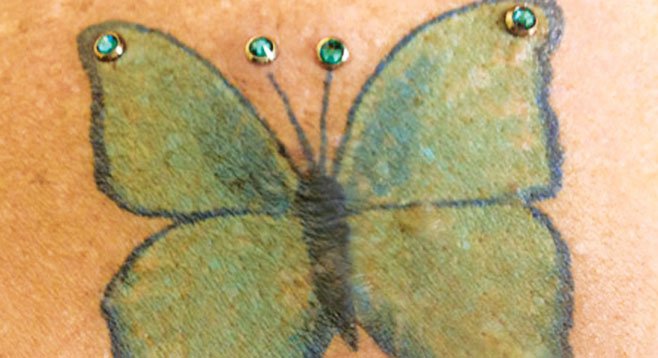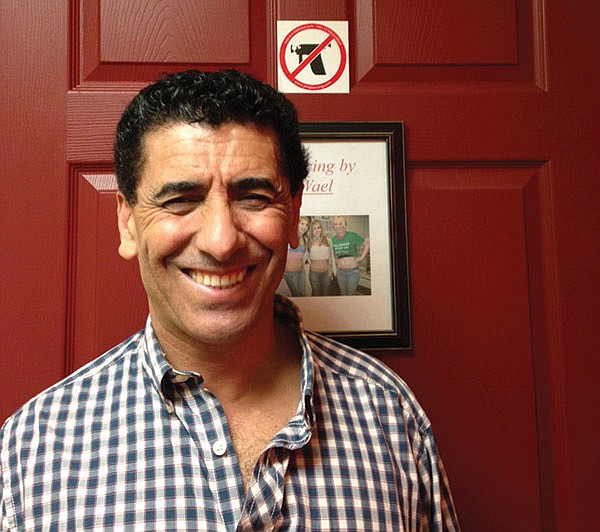 Facebook
Facebook
 X
X
 Instagram
Instagram
 TikTok
TikTok
 Youtube
Youtube

“If you’re going to have a needle stuck in you, you want it done right,” says Wael Hasson, owner of Body Art Salon in Sports Arena (619-222-4210; bodyartbyns.com). “I remind people that a person who does piercing does not need a license, so you want to find a professional who works in sterile conditions. Places that use a piercing gun are problematic, because you can’t put the gun in an autoclave to sterilize it. I have a nursing license, and we have a lot of experience fixing up bad piercings that people get elsewhere, getting them to heal properly.”

The three basics for proper piercing, says Hasson, are placement, jewelry, and aftercare. “You want jewelry to sit right, so that there is no friction. With surface piercings, we look for a place with the least possible amount of motion: neck, cheeks, forearms, back. In the past, we used to use a barbell that went in at one point and came out at another. Now we use dermal anchors. I use a dermal punch to go straight down. Then I remove some of the skin [under the surface] to create a pocket and place the jewelry base under the surface. The skin closes around the stem, and there are holes in the base for the skin to grow into and anchor it. After a few weeks, you can start changing what’s on top of the stem; you can have a gem or a ball or a spike. People like to use them to enhance a tattoo — they might get a gem that serves as the eye of a tiger.”
Some clients ask for surface piercings with skin divers, which use cones instead of anchors, “kind of like an arrow going in. A lot of places won’t do them because of the possibility that they’ll migrate out of the body.” But Hasson says he’s never had a problem. “For divers, I tape the piercing when I do it, and then I have my client come back in 24 hours to see how the piercing is interacting with the body. I make sure that the body is not pushing it out due to muscle movement.”
But whatever you have, it should be made from “internally implantable surgical steel. If you use cheap jewelry — even silver is often mixed with other metals — it can cause irritation and take a long time to heal. Also, the jewelry should be internally threaded, which means that the post is smooth, and the tip or ball that goes on the end has the thread, which goes into the post. If the post has the thread, the rough edges can cause irritation.”
Finally, aftercare is crucial for any piercing. “We give our clients cleaning products and instructions,” says Hasson. “We tell them to wash for five days with anti-microbial soap. Then soak the piercing in warm water that has a pinch of sea salt in it. This kills bacteria, sanitizes the jewelry, loosens scabs, and enhances blood flow. You heal a lot faster.” Prices range from $58 to $147, depending on jewelry and type of piercing. “The average is $80, and we give discounts for multiple piercings.”
Art Aguirre, who owns Church of Steel in Downtown (619-232-5752; churchofsteel.com), is passionate about safe piercing. “All our jewelry is medical implant grade material — inspected, cleaned with an ultrasonic cleaner, and sterilized in an autoclave. Each piercing needs to be its own special moment in your life,” he says. “The experience should be pleasant and memorable. If you’re going to get pierced, ask lots of questions at the establishment, and make sure they make you feel comfortable. I’ve been doing this for 34 years, and I see a lot of people jumping on the bandwagon.”
That experience tells Aguirre what works where. For example, “If you wanted a piercing at the nape of the neck, you’d use a surface bar. It will be more durable than a dermal anchor, because it’s a longer attachment, and it’s at a different level. The dermal anchor could get snagged or rubbed on by the collar of your shirt, and that could cause unnecessary cell activity — the body could reject the anchor. On the other hand, if you’re piercing around the clavicle or sternum, a dermal anchor works best.” Dermal anchor piercings run $50–$60.


“If you’re going to have a needle stuck in you, you want it done right,” says Wael Hasson, owner of Body Art Salon in Sports Arena (619-222-4210; bodyartbyns.com). “I remind people that a person who does piercing does not need a license, so you want to find a professional who works in sterile conditions. Places that use a piercing gun are problematic, because you can’t put the gun in an autoclave to sterilize it. I have a nursing license, and we have a lot of experience fixing up bad piercings that people get elsewhere, getting them to heal properly.”

The three basics for proper piercing, says Hasson, are placement, jewelry, and aftercare. “You want jewelry to sit right, so that there is no friction. With surface piercings, we look for a place with the least possible amount of motion: neck, cheeks, forearms, back. In the past, we used to use a barbell that went in at one point and came out at another. Now we use dermal anchors. I use a dermal punch to go straight down. Then I remove some of the skin [under the surface] to create a pocket and place the jewelry base under the surface. The skin closes around the stem, and there are holes in the base for the skin to grow into and anchor it. After a few weeks, you can start changing what’s on top of the stem; you can have a gem or a ball or a spike. People like to use them to enhance a tattoo — they might get a gem that serves as the eye of a tiger.”
Some clients ask for surface piercings with skin divers, which use cones instead of anchors, “kind of like an arrow going in. A lot of places won’t do them because of the possibility that they’ll migrate out of the body.” But Hasson says he’s never had a problem. “For divers, I tape the piercing when I do it, and then I have my client come back in 24 hours to see how the piercing is interacting with the body. I make sure that the body is not pushing it out due to muscle movement.”
But whatever you have, it should be made from “internally implantable surgical steel. If you use cheap jewelry — even silver is often mixed with other metals — it can cause irritation and take a long time to heal. Also, the jewelry should be internally threaded, which means that the post is smooth, and the tip or ball that goes on the end has the thread, which goes into the post. If the post has the thread, the rough edges can cause irritation.”
Finally, aftercare is crucial for any piercing. “We give our clients cleaning products and instructions,” says Hasson. “We tell them to wash for five days with anti-microbial soap. Then soak the piercing in warm water that has a pinch of sea salt in it. This kills bacteria, sanitizes the jewelry, loosens scabs, and enhances blood flow. You heal a lot faster.” Prices range from $58 to $147, depending on jewelry and type of piercing. “The average is $80, and we give discounts for multiple piercings.”
Art Aguirre, who owns Church of Steel in Downtown (619-232-5752; churchofsteel.com), is passionate about safe piercing. “All our jewelry is medical implant grade material — inspected, cleaned with an ultrasonic cleaner, and sterilized in an autoclave. Each piercing needs to be its own special moment in your life,” he says. “The experience should be pleasant and memorable. If you’re going to get pierced, ask lots of questions at the establishment, and make sure they make you feel comfortable. I’ve been doing this for 34 years, and I see a lot of people jumping on the bandwagon.”
That experience tells Aguirre what works where. For example, “If you wanted a piercing at the nape of the neck, you’d use a surface bar. It will be more durable than a dermal anchor, because it’s a longer attachment, and it’s at a different level. The dermal anchor could get snagged or rubbed on by the collar of your shirt, and that could cause unnecessary cell activity — the body could reject the anchor. On the other hand, if you’re piercing around the clavicle or sternum, a dermal anchor works best.” Dermal anchor piercings run $50–$60.
Comments